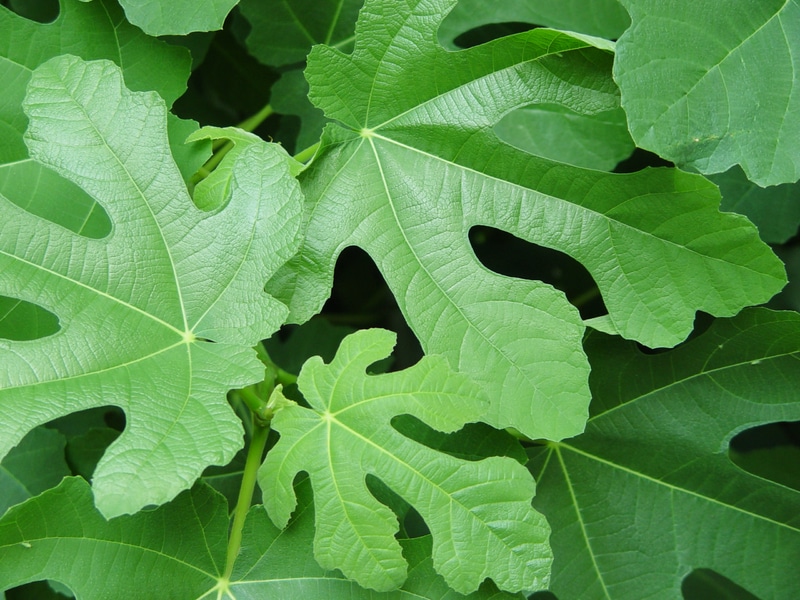Seeing the leaves on your beloved fig tree turning white can be worrying. A fig tree with diseased or damaged leaves may struggle to photosynthesize properly, leading to other issues like poor growth and lack of fruit. Fortunately, in most cases the reasons behind fig leaves turning white are easily identified and treated.
In this article we’ll explore the most common causes of white leaves on fig trees and what you can do about them.
Powdery Mildew
Powdery mildew is one of the most prevalent fungal diseases affecting fig trees. It manifests as small white or gray spots on the leaves. These spots spread, becoming dry, fuzzy or powdery-looking patches. Powdery mildew typically begins on the undersides of leaves or starts on the stems and buds before moving to the leaves.
Powdery mildew thrives in humid conditions with poor air circulation. Overcrowded trees and excessive moisture are perfect environments for outbreaks. It tends to appear in spring and fall when cool humid nights follow warm sunny days. Both outdoor and indoor fig trees can get powdery mildew.
If you spot powdery mildew on your fig tree, act promptly to treat it and prevent its spread:
-
Isolate the affected tree if possible, to avoid infecting other nearby plants Improve air circulation around the fig
-
For indoor fig trees, ventilate the room to reduce humidity and increase airflow.
-
Remove heavily infected leaves to eliminate sources of spore production. Take off only up to 10% of leaves at once to avoid stressing the tree.
-
Apply neem oil which disrupts fungal growth to treat and protect against future outbreaks.
Avoid over-wetting the leaves, overcrowding, and over-fertilizing trees with powdery mildew. Promote good airflow and ample sunlight to prevent recurrence.
Scale Insects
Tiny sap-sucking scale insects can also leave white spots on fig leaves. The insects themselves are often overlooked since they tend to match the color of the leaves. Their feeding causes yellow or white patches, typically concentrated along the main leaf veins.
Scale infestations aren’t normally fatal but can weaken trees and reduce yields if left uncontrolled. Prune off highly infested branches. Use horticultural oil or insecticidal soap to suffocate and kill off scales. Ensure good tree health and vigour, as this makes figs more resistant to scale insects.
Sunscald
Exposure to excess direct sun can bleach fig leaves white. This sunscald damage mainly strikes younger or newly planted trees. Trees kept indoors or in nurseries get sheltered from harsh sunlight. A sudden transition to the bright outdoors can lead to leaf scorch.
Check for a pattern of bleached upper leaves with unaffected lower growth. Sunscald impairs the tree’s health and productivity. Pruning damaged leaves can improve appearance but doesn’t reverse the effects.
When moving a fig tree outside, introduce it to sun gradually. Find a location with partial or dappled sun. Protect young trees with shade cloth if needed. Keep the soil consistently moist as drought stress exacerbates sun damage.
Nutrient Deficiencies
Lack of certain nutrients can interfere with chlorophyll production and turn fig leaves pale. Magnesium deficiency is a prime suspect if foliage is losing greenness but the leaf veins remain dark green. Insufficient iron also causes overall paleness.
Confirm nutrient deficiencies with a soil test. Apply a balanced organic fertilizer or individual mineral amendments as needed. Address overloaded soils by reducing excess fertilizer. Improve drainage in waterlogged roots zones. Mulching helps maintain soil nutrition.
Hard Water Deposits
Using hard water high in minerals to irrigate or mist fig trees can leave white residues on foliage. Water evaporation causes salts and chalky mineral solids to precipitate out on leaf surfaces. Switching to distilled, rain or softened water prevents further buildup.
Gently wipe leaves with a damp cloth to remove existing hard water deposits. Take care not to damage the fragile leaf cuticle. Avoid overzealous rubbing.
Prevention Is Key
Catching and quickly resolving any issues is crucial for keeping your fig tree’s leaves vibrantly green. Inspect regularly for early signs of pests, disease, or environmental stresses. Rapid response helps prevent lasting damage.
Know your fig variety’s specific care needs, like ideal sunlight levels and pruning regimens. Pick a suitable growing site and match care to the location. Promote overall tree health with proper planting techniques, watering, and soil nutrition. Maintaining vigorous growth is a fig tree’s best defense against leaf discoloration.
With prompt troubleshooting and adjustments to care, your fig can recover from white leaves. Rule out serious underlying diseases or pervasive pests, as these may warrant removing badly infested trees entirely. Disinfect tools after pruning diseased plants. Destroying affected branches or leaves prevents problems from spreading.
By taking a proactive approach and addressing issues early on, you can keep your fig tree thriving with full, green leaves. Pay attention to your plant’s needs and take action at the first sign of distress. With timely intervention, you can get your fig’s foliage back to its beautiful vibrant green.
Fig Leaves Turning Yellow. This Is The Solution
FAQ
Why are my fig leaves white?
What does overwatered fig look like?
Why are the leaves on my fig tree turning pale?
Why are my figs turning white?
- A Complete Guide to Caring for Yuki Cherry Blossom Shrub - January 23, 2025
- Identifying Red Hot Poker Seeds: What to Look For When Harvesting Torch Lily Pods - January 23, 2025
- A Complete Guide to Harvesting Evening Primrose Seeds - January 23, 2025

